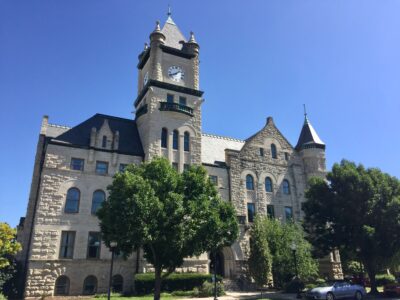Though latest ARPA applications underwent thorough analysis process, highest-priority requests still exceed county’s remaining $21 million in aid

photo by: Journal-World
The west side of the Douglas County Courthouse, 1100 Massachusetts St.
With nearly 100 American Rescue Plan Act funding requests now on the table for the Douglas County Commission’s consideration, there’s still plenty of work ahead before any of the county’s roughly $21 million in COVID relief funding is actually doled out.
Getting to this point in the first place has been a yearlong process, starting when the county first received the ARPA funding on June 17, 2021. Since then, the county first gathered informal letters of interest to help guide policy decisions about where to invest its limited funding and most recently began reviewing official funding applications earlier this week.
Along with giving commissioners a first pass at pointing out some of the proposals they might prioritize when allocating funding, Wednesday’s ARPA funding work session also allowed county staffers to explain how they’ve attempted to streamline the process.
County staff used a number of guideposts to organize applications submitted by external agencies such as nonprofits by tiers of priority. In total, 23 applications are listed as “High” priority and 37 are listed as “Medium” priority.
But even with projects sorted that way, the list of “High” priority proposals still checks in at nearly $34 million in combined funding requests — well over the roughly $21 million the county has left to distribute.
The remaining applications were either judged as “Low” priority or were determined to be ineligible for funding. Commissioners made the decision to eliminate that small group from consideration altogether.
Brooke Sauer, Douglas County’s finance coordinator, told the commission Wednesday that getting proposals organized in this way was the product of a thorough analysis process using a scoring matrix, which gives greater weight to certain sections of the application in the interest of aligning with the county’s spending priorities.
For instance, Sauer said the project information section — which asks applicants to provide details like whether a project calls for one-time or ongoing funding and whether it was submitted as part of a collaborative effort with another agency — was the most heavily-weighted section of the matrix, accounting for 35% of the total weighted score for each proposal. Other sections of the application were given less weight: The project’s grant capacity and an equity impact analysis weighed in at 15% and 20% of the overall score, respectively.
For the equity impact analysis section, Sauer said responses from applicants varied greatly in how thorough they were. Commissioners asked for that section in particular to be included with the final application earlier in the process.
“Some applicants submitted proposals with extremely rich narratives including statistics, data-driven outcomes and policy citations,” Sauer said. “Some proposals provided brief statements of intent or a simple ‘Yes’ remark.”
Other considerations outlined by county staff included whether the applicant had received pandemic relief funding previously and whether the projects would be countywide investments, as opposed to projects aimed at targeted communities.
The commission is set to take another look at funding applications this coming Wednesday; county staff also floated the idea of including an ARPA discussion on the commission’s regular meeting agenda for next week if commissioners think they’ll need more time. So far, the commission has not discussed any funding requests from county governmental offices.







